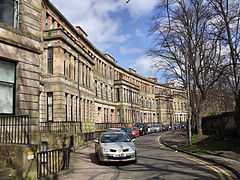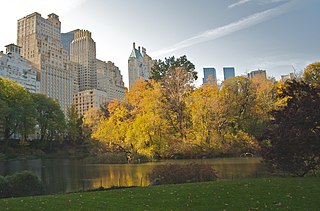
An apartment, or flat, is a self-contained housing unit that occupies part of a building, generally on a single story. There are many names for these overall buildings, see below. The housing tenure of apartments also varies considerably, from large-scale public housing, to owner occupancy within what is legally a condominium, to tenants renting from a private landlord.
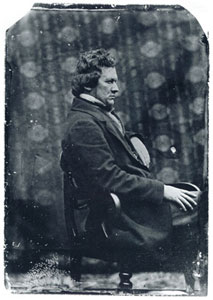
Alexander "Greek" Thomson was an eminent Scottish architect and architectural theorist who was a pioneer in sustainable building. Although his work was published in the architectural press of his day, it was little appreciated outside Glasgow during his lifetime. It has only been since the 1950s and 1960s that his critical reputation has revived—not least of all in connection with his probable influence on Frank Lloyd Wright.

Pollokshields is an area in the Southside of Glasgow, Scotland. Its modern boundaries are largely man-made, being formed by the M77 motorway to the west and northwest with the open land of Pollok Country Park and the Dumbreck neighbourhood beyond, by the Inverclyde Line railway and other branches which separate its territory from the largely industrial areas of Kinning Park, Kingston and Port Eglinton, and by the Glasgow South Western Line running from the east to south, bordering Govanhill, Strathbungo, Crossmyloof and Shawlands residential areas. There is also a suburban railway running through the area.

North Kelvinside is a residential district of the Scottish city of Glasgow.

Strathbungo is a mainly residential area of southern Glasgow, Scotland, bordered by the neighbourhoods of Crossmyloof to the south, Govanhill to the east and Pollokshields to the north and west. The settlement grew up as a small isolated village built along the Pollokshaws Road, one of the main arteries leading southwards from the centre of Glasgow, adjoined by the Camphill Estate, now part of Queens Park. Strathbungo lay just inside Govan parish, on its boundary with Cathcart parish, and at one time a line just north of Allison Street and Nithsdale Street formed the boundary or 'march' between the counties of Lanark and Renfrew.

Netherlee is a suburban residential area in East Renfrewshire, Scotland. It is situated on the west bank of the White Cart Water about 4 miles (6.5 km) south of Glasgow city centre. Part of the Greater Glasgow conurbation, it is mostly contiguous with the city, and is just beyond the boundary of its local authority area. It is a separate census locality from Glasgow, like other areas such as neighbouring Giffnock and Clarkston. Netherlee is directly contiguous with Stamperland. It is also in a council ward with Clarkston and its neighbour Busby. As of 2012, Netherlee has a population of 4,550.
Cranhill is an inner city district and housing scheme in the north east of Glasgow, Scotland. Cranhill was developed from public funding in the early 1950s and was originally, chiefly composed of four-storey tenement blocks surrounding a patch of grassland, which became Cranhill Park. Later development saw the building of three tower blocks, surrounded by rows of terraced maisonettes. In more recent years, a number of semi-detached and detached homes have been built. The area also hosts some shops, two primary schools and nurseries, a community centre and the Cranhill water tower.

Anniesland Court is a 22-storey residential tower block in the Anniesland area of Glasgow, Scotland, designed by J Holmes & Partners and completed in 1968. It is the tallest listed building in Scotland, and is remarkably similar to Ernő Goldfinger's later and more famous Trellick Tower in London. It is the only tower block in Glasgow to have been granted a category A listing.

Cessnock subway station is a station on the Glasgow Subway that serves the eastern part of Ibrox and the Cessnock area of the city. It is also the nearest station to Festival Park. Along with Kelvinhall, it is one of only two stations to retain its pre-modernisation surface buildings and entryway. It is also the only station to retain its pre-modernisation livery and signage. The entrance is at the east end of Walmer Crescent and leads under the residential housing.

Cables Wynd House, better known as the Leith Banana Flats or the Banana Block because of its curved shape, is a nine-storey local authority housing block in Leith, Edinburgh. The building, in fact, has ten storeys. The ground floor is called Cables Wynd and the nine floors above constitute Cables Wynd House. This often leads to confusion in postal and other services. Communal heating and other energy measures have recently been installed by the City of Edinburgh Council.
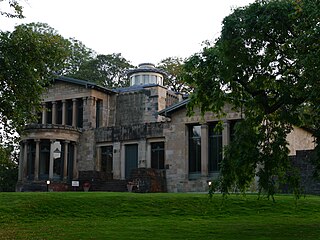
Holmwood House is the finest and most elaborate residential villa designed by the Scottish architect Alexander "Greek" Thomson. It is also rare in retaining much of its original interior decor, and being open to the public. A Category A listed building, the villa is located at 61-63 Netherlee Road, Cathcart, in the southern suburbs of Glasgow, and is owned by the National Trust for Scotland.
Cessnock is an area in the city of Glasgow, Scotland. It is situated south of the River Clyde and was part of the former Burgh of Govan. Cessnock's main street is Paisley Road West, which runs west in the direction of Paisley and east through Kinning Park to Paisley Toll.

The Centre for Contemporary Arts (CCA) is an arts centre in Glasgow, Scotland. The year-round programme includes exhibitions, film, music, literature, spoken word, festivals, Gaelic and performance. The Centre works with artists, commissions new projects and presents them to the widest possible audience.

Millbrae Crescent is a street located in Glasgow providing numerous examples of category A listed buildings thought to be designed by Alexander "Greek" Thomson, or posthumously by his architectural partner, Robert Turnbull. The street comprises an elegant row of two-storey terraced houses built using blonde sandstone and exemplifying Thomson's typical use of Egyptian-derived columns and ornamentation. Millbrae Crescent is located on the River Cart in Langside, Glasgow, and within close proximity of Thomson's noted residential Victorian villa, Holmwood House. The crescent, which is located near the White Cart Water river, has been a high risk area for flooding over the years.

Glasgow, the largest city in Scotland, has several distinct styles of residential buildings, and since its population began to grow rapidly the 18th century has been at the forefront of some large-scale projects to deal with its housing issues, some of which have been assessed as being largely successful and others less so.

The Egyptian Halls is a category A listed building at 84–100 Union Street, Glasgow, Scotland. It was built between 1870–72 and designed by Alexander "Greek" Thomson. Other than some retailers on the ground floor, the building is currently unoccupied. Despite several attempts at restoration, it remains in a parlous state and was under threat of demolition in 2011. Planning approval and listed building consent has since been given for a scheme which has secured funding for conversion to a 114-bed four-star hotel. As of 20 February 2013, subsidy was still being sought for work to the ground floor.

Royal Terrace is a grand street in the city of Edinburgh, Scotland, on the north side of Calton Hill within the New Town and part of the UNESCO World Heritage Site inscribed in 1995, built on the south side of a setted street, facing the sloping banks of London Road Gardens, formerly Royal Terrace Gardens, with views looking north towards Leith and the Firth of Forth.

Carlton Terrace is a residential street in Edinburgh, Scotland. It is located on the east side of Calton Hill, at the eastern extremity of the New Town, part of the UNESCO World Heritage Site inscribed in 1995.
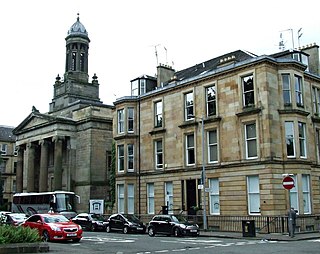
Kelvingrove is a neighbourhood in the city of Glasgow, Scotland. It is situated north of the River Clyde in the West End of the city, and directly borders Kelvingrove Park to the north and the grounds of the Kelvingrove Art Gallery and Museum to the west. Its other boundaries are not precisely defined, but roughly correspond to Sauchiehall Street to the south opposite the Sandyford neighbourhood, and the Charing Cross area to the east.
